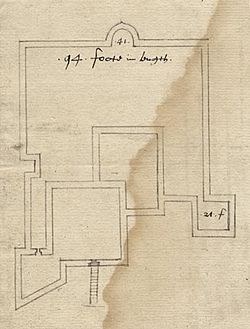Sandown Castle, Isle of Wight facts for kids
Quick facts for kids Sandown Castle |
|
|---|---|
| Sandown, Isle of Wight, England | |

1559 plan of Sandown Castle
|
|
| Coordinates | 50°39′24″N 1°08′49″W / 50.65669°N 1.14691°W |
| Type | Henrician castle |
| Site information | |
| Condition | Destroyed |
| Site history | |
| Built | 1545 |
| Demolished | 1631 |
Sandown Castle was a special fort built in 1545. King Henry VIII had it built in Sandown, on the Isle of Wight. Its main job was to protect England from possible attacks by France.
The castle was made of stone. It had unique angled sections called bastions. These parts mixed new Italian ideas for forts with older English designs. While the castle was still being built, French soldiers actually attacked the area that summer. Over time, the sea wore away at the land around the castle. Because of this coastal erosion, the castle had to be taken down in 1631.
Contents
Why Was Sandown Castle Built?
England's Coastal Defenses
In the 1500s, there was a lot of tension between England, France, and the Holy Roman Empire. King Henry VIII was in charge of England. Usually, towns and local leaders were in charge of protecting the coast. The king didn't get involved much in building forts.
At first, France and the Holy Roman Empire were fighting each other. This meant a big invasion of England seemed unlikely. There were some small forts, like simple blockhouses, along the coast. But overall, England didn't have many strong defenses.
A King's Decision
Things changed in 1533. King Henry VIII decided to end his marriage to Catherine of Aragon. This made the Pope, Pope Paul III, very angry. Because of this, France and the Holy Roman Empire became allies against Henry in 1538. The Pope even encouraged them to attack England.
To protect his country, Henry VIII gave an order in 1539. He called this order a "device." It said that new forts should be built along the most vulnerable parts of England's coast. The immediate danger passed, but it came back in 1544. France threatened to invade England across the English Channel. They also had help from their allies in Scotland. So, King Henry issued another "device" in 1544. This time, he wanted even more improvements to England's defenses, especially along the south coast.
Building Sandown Castle
How It Was Made
Sandown Castle was built between April and September in 1545. It was meant to protect the southeast coast of the Isle of Wight. The castle looked over Sandown Bay.
An Italian engineer named Giovanni Portinari helped design it. William Ridgeway was the surveyor, and John Portinar led the workers. Building the castle cost about £2,400, which was a lot of money back then!
The castle had a central courtyard. It featured a square tower and two angled bastions on one side. A round bastion faced the sea. A moat (a ditch filled with water) protected the back of the stone walls. There was also a wooden pier where boats could dock.
New Ideas for Forts
The angled bastions used in Sandown Castle were a new idea. They came from Italian thinking about military buildings. These ideas might have come from Richard Lee, the King's Surveyor of Works. Giovanni Portinari's background from mainland Europe also played a part.
Even though it was quite modern for an English fort, Sandown Castle didn't have the very newest "arrow-head" bastion design. That design was used at nearby Yarmouth Castle. Some historians have said Sandown Castle was a mix of old and new ideas.
French Attack!
The castle wasn't even finished when the French attacked! On July 19, Admiral Claude d'Annebault crossed the Channel. He arrived near the Solent with 200 ships. Local leaders worried that Sandown Castle might be attacked at night.
About 2,000 French soldiers landed on the Isle of Wight. They attacked Sandown, where workers were still building the castle. But their attack didn't go well. The French soon retreated back to their ships. This ended the invasion threat. After they left, the castle was finally completed.
The Castle's End
Falling Apart
By the 1600s, the sea had caused a lot of damage. Coastal erosion had worn away the land, weakening the castle's walls. In 1627, King Charles I said he would fix the fort.
However, instead of repairing it, the castle's ruins were taken apart in 1631. Sir John Oglander was in charge of this. A new fort, called Sandown Fort, was built in its place. This new fort was built further inland, away from the eroding coast.
Today, if you visit the shore at low tide, you might still see some possible remains of the original castle's foundations.


